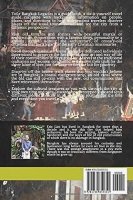- Home
- Bangkok Museums
- Bank of Thailand Museum
Bank of Thailand Museum
a millennium of financial history
By Eric Lim
The Bank of Thailand Museum is housed in the Bang Khun Phrom Palace, the former residence of HRH Prince Paribatra Sukhumbhand, the 33th son of King Chulalongkorn.
Designed by Italian architect, Mario Tamagno, the palace is another legacy of Italian artistry in Bangkok. Construction of the main building in Bang Khum Phrom Palace started in 1901 and was completed in 1906.
It’s a majestic palace of 14 rooms overlooking the stretch of the Chao Phraya River spanned by the Rama VIII Bridge.
The second building, the Somdej building was built later around 1913 for the prince's mother H.M. Queen Sukhumala Marasri.This time Karl Dohring a German architect, provided the design.
Dohring was also responsible for the Varadis Palace the royal residence of Prince Damrong Rachanupab, a son of King Mongkut (King Rama IV).
In 1945 the Bang Khum Phrom Palace became the office of the Bank of Thailand, the central bank, till 1992 when it was restored and converted to a museum.
His Majesty King Bhumipol Adulyadej officially opened the Bank of Thailand Museum on 9 January 1993.
Please see map to the Bank of Thailand Museum.
Various rooms within the palace display the history of Thai currency and the Bank of Thailand. Of special interest are the coin rooms showing the evolution of currency used in Thailand since the 1st century.
The history of Thai currency dates from the days of barter trade, ancient coins till the currency in modern times. In the early days, beads, seeds, bracelets were used as a medium of exchange.
It is interesting to note that old Roman copper coins have been found in excavation sites.
The displays trace the use of Funan coins (1st – 7th centuries) to the Sri Vijaya coins (8th – 13th centuries).
During the Sukhothai period, (13th – 14th centuries) Pot Duang coins in the shape of shells were used.
From the 14th – 19th centuries, coins from the Lanna Kingdom in the northern Thailand made their appearance.
During the reign of King Rama IV, when foreign trade and diplomatic relations expanded, the first bank notes were issued in 1853. In 1857, Queen Victoria of Britain presented Thailand with the first minting machine and the minting of Thai coins started in 1858.
Besides the history of the evolution of Thai currency, the Bank of Thailand Museum also preserves the history of the Bank of Thailand, Bang Khun Phrom Palace and mementos of the life and works of Prince Paribatra.
In the royal reception room, resplendent with portraits, rich carpets and chandeliers are photographs commemorating the visit by Queen Elizabeth and Prince Phillip in 1996.
In keeping with the banking tradition of Bang Khun Phrom Palace and Prince Paribatra, two of his grandsons subsequently became Governors of the Bank of Thailand, M R Chatu Mongol Sonakul and M R Pridiyathorn Devakula.
The latter was the Deputy Prime Minister and Finance Minister briefly in 2006/7.
The Bank of Thailand Museum in Bang Khun Phrom Palace is one of those Bangkok museums that preserves a special aspect of Thai history. It’s a legacy of a millennium of the financial history of Thailand.
On 28 December 2006, Bang Khun Phrom Palace celebrated its centenary. Guests for the ceremony dressed in traditional Thai costumes and mingled in an atmosphere with traditional Thai music to relive the days when Prince Paribatra held court.
Map to the Bank of Thailand Museum
View Larger Map
How to get there
The museum is in Wisut Kasat Road off Samsen Road near the Bang Khun Phrom junction. The prominent landmark there is the King Rama VIII suspension bridge
It is housed in the Bang Khun Prom Palace which is within the premises of the Bank of Thailand. The palace is to the left of the main office block.
With its Italian architecture, the palace stands out from the modern design of the main office buildings in the Bank of Thailand premises.
A convenient way of getting there is by Chao Phraya river boat to the Phra Arthit Pier and take a taxi or tuk tuk there.
The museum is open from Mondays – Fridays between 09:30 am – 04:00 pm. Previously only group tours with appointments made in advance are admitted. That has changed.
Update on visiting hours to Bang Khun Phrom Palace
Recently the Bank of Thailand announced that the Bank of Thailand Museum in Bang Khun Phrom Palace will be open to walk-in visitors every Saturday.
Walk-in visitors are requested to come at half an hour earlier for the distribution of queue numbers for the tour. The tour groups will be limited to 90 – 100 persons. These are the timings for getting your queue numbers for the walk-in tours.
1000 hours for the 1030 hours tour
1100 hours for the 1130 hours tour
1300 hours for the 1330 hours tour
1400 hours for the 1430 hours tour
Group tours will be conducted from Mondays to Fridays from 0930 – 1200 hours and 1300 – 1600 hours. Such groups must make appointments for these tours in writing two weeks in advance.
All tours will be guided by Bang of Thailand staff who will provide visitors with information on the museum and its exhibits.
The museum will be closed on Sundays and public holidays.
Visitors please note that Bang Khun Phrom Palace was a former royal residence, so please dress appropriately. No photographs are allowed inside the museum.
For more information, please contact:
0-2283-5286, 0-2283-6723, 0-2283-6152,
0-2356-7702, 0-2283-5265
For the other works of Mario Tamagno, please see Italian Architects in Bangkok. For other Bangkok Museums.
Related page
Tour Bangkok Legacies - Kindle paperback edition
For those who prefer reading printed books rather than e-books, here's the paperback edition of Tour Bangkok Legacies, which will help you along as you explore the streets of Bangkok and discover its old treasures. It's complete with historical descriptions and directions on how to get to these places.
My Kindle paperback edition
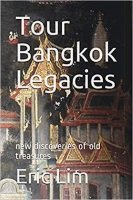
Search Tour Bangkok Legacies with DuckDuckGo
Related page
Ananda Samakhom Throne Hall
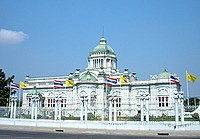
Government House
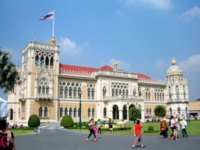
Neilson Hays Library
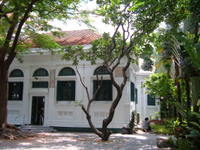
Santa Cruz Church
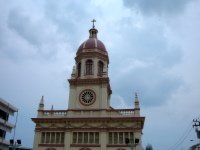
Siam Commercial Bank
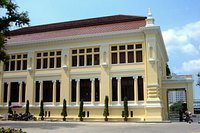
My Journey through Thailand
Part I The First Steps
My Kindle edition

My Smashwords edition

